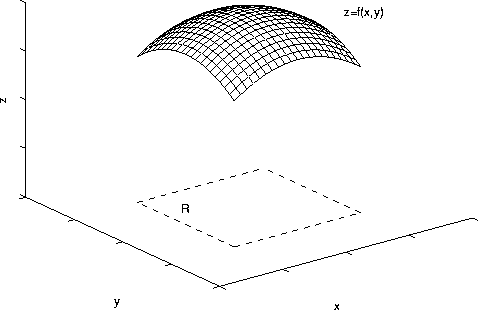Basic idea
Let's say you want to find the mass of a rope that's not of uniform density. You have to travel along the path and integrate by the adding the masses of each small slice of the rope.
MathJax TeX Test Page
We can represent the integral along the path as
$$\int_C f(x,y) \, \mathrm{d}s = \int_a^b f(g(t), h(t))\sqrt{(g'(t))^2 + (h'(t))^2}\, \mathrm{d}t $$
The only restriction is it has to be smooth, meaning $f'(x,y)$ is never 0.
MathJax TeX Test Page
Instead of writing in terms of $\mathrm{d}s$, we can write it as
$$\int_C f(x,y)\,\mathrm{d}x = \int_C f(x(t),y(t))x'(t)\,\mathrm{d}t$$
Note that if y'(t) = 0 in the original equation, it's the same thing, so this is independent of y. We can do the same thing with x.
$$\int_C f(x,y)\,\mathrm{d}y = \int_C f(x(t),y(t))y'(t)\,\mathrm{d}t$$
We can generalize and write this:
$$\int_C M(x,y)\, \mathrm{d}x + \int_C N(x,y)\, \mathrm{d}y$$
That's usually shortened to
$$\int_C M(x,y)\, \mathrm{d}x + N(x,y)\, \mathrm{d}y$$ In order to evaluate this, you must turn both d_'s into the same thing, be it $\mathrm{d}x$ or $\mathrm{d}t$.
MathJax TeX Test Page
Evaluate $\int_C xy\, \mathrm{d}x + x^2\, \mathrm{d}y$, if C is the curve $y = x^2 + 3$ from $0 \leq x \leq 5$.
The first thing we do is write $y = x^2 + 3, dy = 2xdx$, using the same notation as u-subs. Then, all we have to do is replace all the $y$'s with $x^2 + 3$'s, and we're set.
$$\int_0^5 x\left(x^2 + 3\right)dx + x^2(2x)dx$$
$$=\int_0^5 3x^3 + 3x\, \mathrm{d}x=\boxed{\frac{2025}{4}}$$
Example: same question, but parametric
MathJax TeX Test Page
Evaluate $\int_C xy\, \mathrm{d}x + x^2\, \mathrm{d}y$, if C is the curve $x = t$, $y = t^2 + 3$ from $0 \leq x \leq 5$.
The first thing we do is find what dx and dy are. $$x = t, dx = dt, y = t^2 + 3, dy = 2tdt$$
This particular problem works out the exact same way, and that's why I wanted to show the two methods. Sometimes parametric is better, sometimes the normal form is better, it depends.
$$\int_0^5 x\left(x^2 + 3\right)dx + x^2(2x)dx$$
$$=\int_0^5 3x^3 + 3x\, \mathrm{d}x=\boxed{\frac{2025}{4}}$$
MathJax TeX Test Page
A major application of line integrals deals with the work done by moving through a force field. So, imagine a submarine moving around the violent ocean. The current at each point is different, so it's nontrivial to caluclate the work done by moving from one place to another.
Now, the work is the sum of all of the $\Delta{}W$s. When the area you're looking at is so small, there is a constant force acting upon a point, and the direction is constant. Recall from section 14.3 that the work down by a constant force along a direction $V$ is $F \cdot V$. Using that, we can say
$$\Delta{}w_i = F(u_i, v_i, w_i) \cdot < \Delta{}x_i, \Delta{}y_i, \Delta{}z_i >$$
$$ = M(u_i, v_i, w_i)\Delta{}x_i + N(u_i, v_i, w_i)\Delta{}y_i + P(u_i, v_i, w_i)\Delta{}z_i$$
So, $$W = \int_C M(x,y,z)\, \mathrm{d}x + N(x,y,z)\, \mathrm{d}y + P(x,y,z)\, \mathrm{d}z$$
Finally, we can say that
$$W = \int_C F \cdot T\, \mathrm{d}s$$
$T$ is the unit tangent vector, and recall we're taking the dot product of many constant-direction works, so we need the unit tangent vector.
In addition, this is equal to $\int_C F \cdot dr$, and $dr = dxi + dyj + dzk$.
MathJax TeX Test Page
The force at a point (x,y,z) is given by $< y, z, x>$. Find the work along the curve $x = t, y = t^2, z = t^3, 0 \leq t \leq 2$.
$$\int_C F \cdot dr = \int_C ydx + zdy + xdz$$
$$dx = dt, dy = 2tdt, dz = 3t^2dt$$
$$=\int_0^2 t^2dt + t^3(2tdt) + t(3t^2dt)$$
$$=\int_0^2 t^2 + 2t^4 + 3t^3\, \mathrm{d}t = \boxed{\frac{412}{15}}$$

